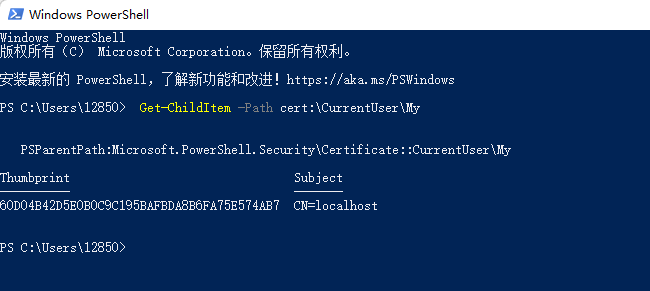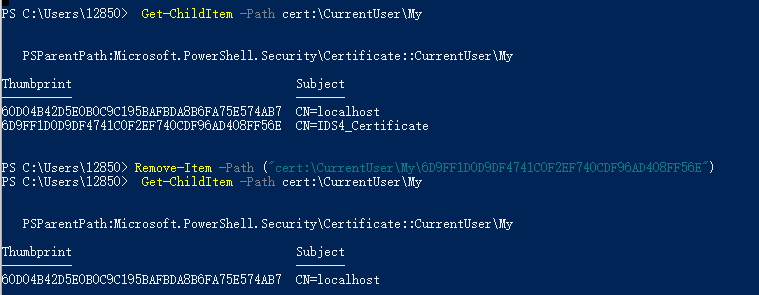NETCORE - IdentityServer4 客户端凭据模式
NETCORE - IdentityServer4 客户端凭据模式
一. 创建服务端
项目:NETCORE.ID4.ClientSecrets.Server (.Net6 web api)
1. 安装IdentityServer4 依赖包

2. 创建config.cs配置类
using IdentityServer4; using IdentityServer4.Models; using System.Collections; using System.Collections.Generic; namespace NETCORE.ID4.ClientSecrets.Server { public class Config { public static IEnumerable<IdentityResource> IdentityResources => new IdentityResource[] { new IdentityResources.OpenId(), new IdentityResources.Profile() }; // v4新增 public static IEnumerable<ApiScope> ApiScopes => new ApiScope[] { new ApiScope("OrderApi", "Order Api") }; public static IEnumerable<ApiResource> GetApiResources() { return new List<ApiResource> { new ApiResource("API1", "第一个接口") { //重要 Scopes = { "scope1" } } }; } public static IEnumerable<Client> Clients => new Client[] { //客户端的唯一标识 此模式可用于前端 new Client { // 客户端的唯一标识 ClientId="client", // 客户端认证密码 ClientSecrets = { new Secret("ordersecret".Sha256()) }, // 指定授权模式,这里指定为客户端凭据模式 AllowedGrantTypes = GrantTypes.ClientCredentials, // 指定客户端获取的Token能访问到的作用域 AllowedScopes={ "OrderApi" } }}; } }
3. 注入 IdentityServer,在Program.cs中
using NETCORE.ID4.ClientSecrets.Server; var builder = WebApplication.CreateBuilder(args); // Add services to the container. builder.Services.AddControllers(); // Learn more about configuring Swagger/OpenAPI at https://aka.ms/aspnetcore/swashbuckle builder.Services.AddEndpointsApiExplorer(); builder.Services.AddSwaggerGen(); // 使用内存存储,密钥,客户端和资源来配置身份服务器。 builder.Services.AddIdentityServer(options => { //注意区分ApiScope和ApiResource, //这里的ApiScope并不会生成Access Token里面的Audience属性, 因此我们设置EmitStaticAudienceClaim = true(见IdentityServer的Starup文件)来指定一个固定的Audience。 //如果需要使用Api的名称作为Audience,则要使用ApiResource options.EmitStaticAudienceClaim = true; }) //添加开发人员签名凭据 //开发时使用的 AddDeveloperSigningCredential(),不适合生产环境。 //生产环境使用 AddSigningCredential .AddDeveloperSigningCredential() .AddInMemoryIdentityResources(Config.IdentityResources) .AddInMemoryApiScopes(Config.ApiScopes) .AddInMemoryClients(Config.Clients); var app = builder.Build(); // Configure the HTTP request pipeline. if (app.Environment.IsDevelopment()) { app.UseSwagger(); app.UseSwaggerUI(); } app.UseHttpsRedirection(); app.UseIdentityServer();//启动ids4中间件 //app.UseAuthentication();//添加鉴权验证 //app.UseAuthorization(); app.MapControllers(); app.Run();
访问发现文档: https://localhost:7022/.well-known/openid-configuration
{ "issuer": "https://localhost:7022", "jwks_uri": "https://localhost:7022/.well-known/openid-configuration/jwks", "authorization_endpoint": "https://localhost:7022/connect/authorize", "token_endpoint": "https://localhost:7022/connect/token", "userinfo_endpoint": "https://localhost:7022/connect/userinfo", "end_session_endpoint": "https://localhost:7022/connect/endsession", "check_session_iframe": "https://localhost:7022/connect/checksession", "revocation_endpoint": "https://localhost:7022/connect/revocation", "introspection_endpoint": "https://localhost:7022/connect/introspect", "device_authorization_endpoint": "https://localhost:7022/connect/deviceauthorization", "frontchannel_logout_supported": true, "frontchannel_logout_session_supported": true, "backchannel_logout_supported": true, "backchannel_logout_session_supported": true, "scopes_supported": [ "openid", "profile", "OrderApi", "offline_access" ], "claims_supported": [ "sub", "name", "family_name", "given_name", "middle_name", "nickname", "preferred_username", "profile", "picture", "website", "gender", "birthdate", "zoneinfo", "locale", "updated_at" ], "grant_types_supported": [ "authorization_code", "client_credentials", "refresh_token", "implicit", "urn:ietf:params:oauth:grant-type:device_code" ], "response_types_supported": [ "code", "token", "id_token", "id_token token", "code id_token", "code token", "code id_token token" ], "response_modes_supported": [ "form_post", "query", "fragment" ], "token_endpoint_auth_methods_supported": [ "client_secret_basic", "client_secret_post" ], "id_token_signing_alg_values_supported": [ "RS256" ], "subject_types_supported": [ "public" ], "code_challenge_methods_supported": [ "plain", "S256" ], "request_parameter_supported": true }
从前端获取 token: https://localhost:7022/connect/token
参数:
|
client_id
|
client |
| client_secret | ordersecret |
| grant_type | client_credentials |

一. 创建客户端
项目:NETCORE.ID4.ClientSecrets.Client(.Net6 web api)
1. 安装 IdentityServer4.AccessTokenValidation 依赖包

创建 WEBAPI 控制器
using Microsoft.AspNetCore.Authorization; using Microsoft.AspNetCore.Http; using Microsoft.AspNetCore.Mvc; namespace NETCORE.ID4.ClientSecrets.Client.Controllers { [Route("api/[controller]")] [ApiController] public class ValuesController : ControllerBase { [HttpGet] [Route("get1")] public IActionResult Get1() { return Ok("ok by no auth"); } [HttpGet] [Route("get2")] [Authorize] public IActionResult Get2() { return Ok("ok by no auth"); } } }
调用接口


调用 get2 方法时,没有设置 token 会报401
配置 token 后,可获取到数据

Identity Server4/生产模式/证书/certificate/AddSigningCredential
开发时使用的 AddDeveloperSigningCredential(),不适合生产环境。
戳几字,简单使用PowerShell读取.CER 文件, 使用.NET X509Certificate2这个类,生成、读取、删除证书。
打开 window powershell
2. 读取证书
输入 Get-ChildItem -Path cert:\CurrentUser\My

3.创建证书
输入 New-SelfSignedCertificate -Subject "CN=IDS4_Certificate" -CertStoreLocation cert:\CurrentUser\My -Provider "Microsoft Strong Cryptographic Provider"
名为 IDS4_Certificate

删除证书,输入 Remove-Item -Path ("cert:\CurrentUser\My\" + $cert.Thumbprint)

5. 加载刚生成的证书,输入
$cert = Get-ChildItem -Path cert:\CurrentUser\My\(your certificate thumbprint)

6. 导出公钥到项目文件夹,输入
Export-Certificate -Type CERT -Cert $cert -FilePath "./publickey.cer"

导出私钥到项目文件夹
输入 $cred = Get-Credential 配置秘钥
用户名:test
密钥:123456


输入 Export-PfxCertificate -Cert $cert -Password $cred.Password -FilePath "./private.pfx"

配置identity server4 使用生成的证书
string certPath = "C://Users/12850/private.pfx"; var certificate = new X509Certificate2(certPath, "123456"); // 使用内存存储,密钥,客户端和资源来配置身份服务器。 builder.Services.AddIdentityServer(options => { //注意区分ApiScope和ApiResource, //这里的ApiScope并不会生成Access Token里面的Audience属性, 因此我们设置EmitStaticAudienceClaim = true(见IdentityServer的Starup文件)来指定一个固定的Audience。 //如果需要使用Api的名称作为Audience,则要使用ApiResource options.EmitStaticAudienceClaim = true; }) //添加开发人员签名凭据 //开发时使用的 AddDeveloperSigningCredential(),不适合生产环境。 //生产环境使用 AddSigningCredential //.AddDeveloperSigningCredential() .AddSigningCredential(certificate) .AddInMemoryIdentityResources(Config.IdentityResources) .AddInMemoryApiScopes(Config.ApiScopes) .AddInMemoryClients(Config.Clients);
参考:https://www.cnblogs.com/yakniu/p/16175739.html
参考:https://blog.csdn.net/m0_62367247/article/details/127033649


